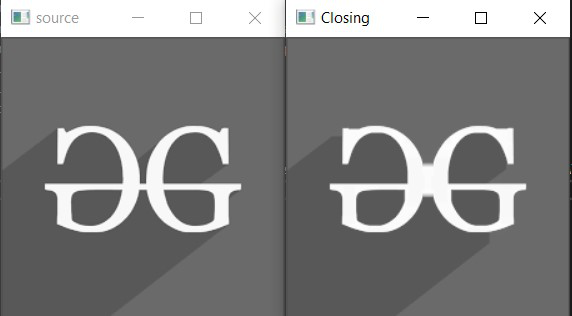Closing | Morphological Transformations in OpenCV in C++
Last Updated :
10 Feb, 2021
In this article, a Morphological Operation called Closing is discussed.
- It helps to reduce the internal noise present inside an image.
- In this article, another operator is elaborated called closing which is just the reverse of Opening and applies dilation followed by erosion.
- Just like the Opening operator it also uses a structuring element but it is used for removing small holes instead of pertusions.
Syntax:
morphologyEx (src, dst, op, kernel, anchor, iterations, borderType, borderValue)
Parameters:
- src: It is the input image.
- dst: It is the output image.
- op: Type of morphological operation.
- kernel: Structuring element used for Closing.
- anchor: Anchor position inside the structuring element. The default value is [-1, -1} signifying position as the center of the structuring element.
- iterations: Number of times Closing is applied.
- borderType: Type of border ( BORDER_CONSTANT, BORDER_REPLICATE, etc.)
- borderValue: Border value
- Return: Output Image (Mat Object)
The closing operation is given by the expression:

- The expression represents the fact that A is a sub-image of A.B.
- This operator is used to remove small holes from the image.
- It also helps in smoothening the contours and fusion of narrow breaks and long thin gulfs.
Below is the program demonstrating the Closing Morphological Operator:
C++
#include <opencv2/highgui/highgui.hpp>
#include <opencv2/imgproc.hpp>
using namespace cv;
using namespace std;
void closingMorphological()
{
Mat image = imread(
"C:/Users/harsh/Downloads/geeks.png",
IMREAD_GRAYSCALE);
if (!image.data) {
cout << "Could not open or "
<< "find the image\n";
return 0;
}
int morph_size = 2;
Mat element = getStructuringElement(
MORPH_RECT,
Size(2 * morph_size + 1,
2 * morph_size + 1),
Point(morph_size, morph_size));
Mat output;
morphologyEx(image, output,
MORPH_CLOSE, element,
Point(-1, -1), 2);
imshow("source", image);
imshow("Closing", output);
waitKey();
}
int main(int argc, char** argv)
{
closingMorphological();
return 0;
}
|
Output:

Like Article
Suggest improvement
Share your thoughts in the comments
Please Login to comment...